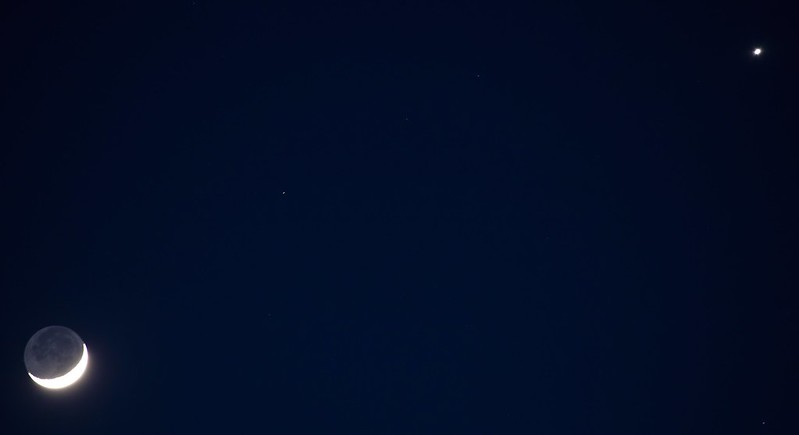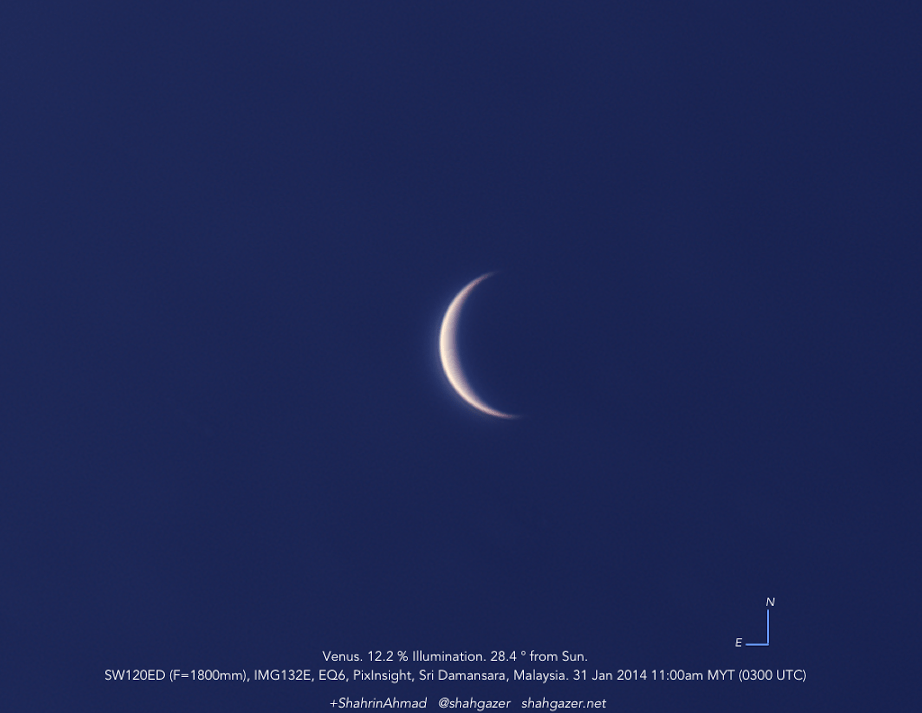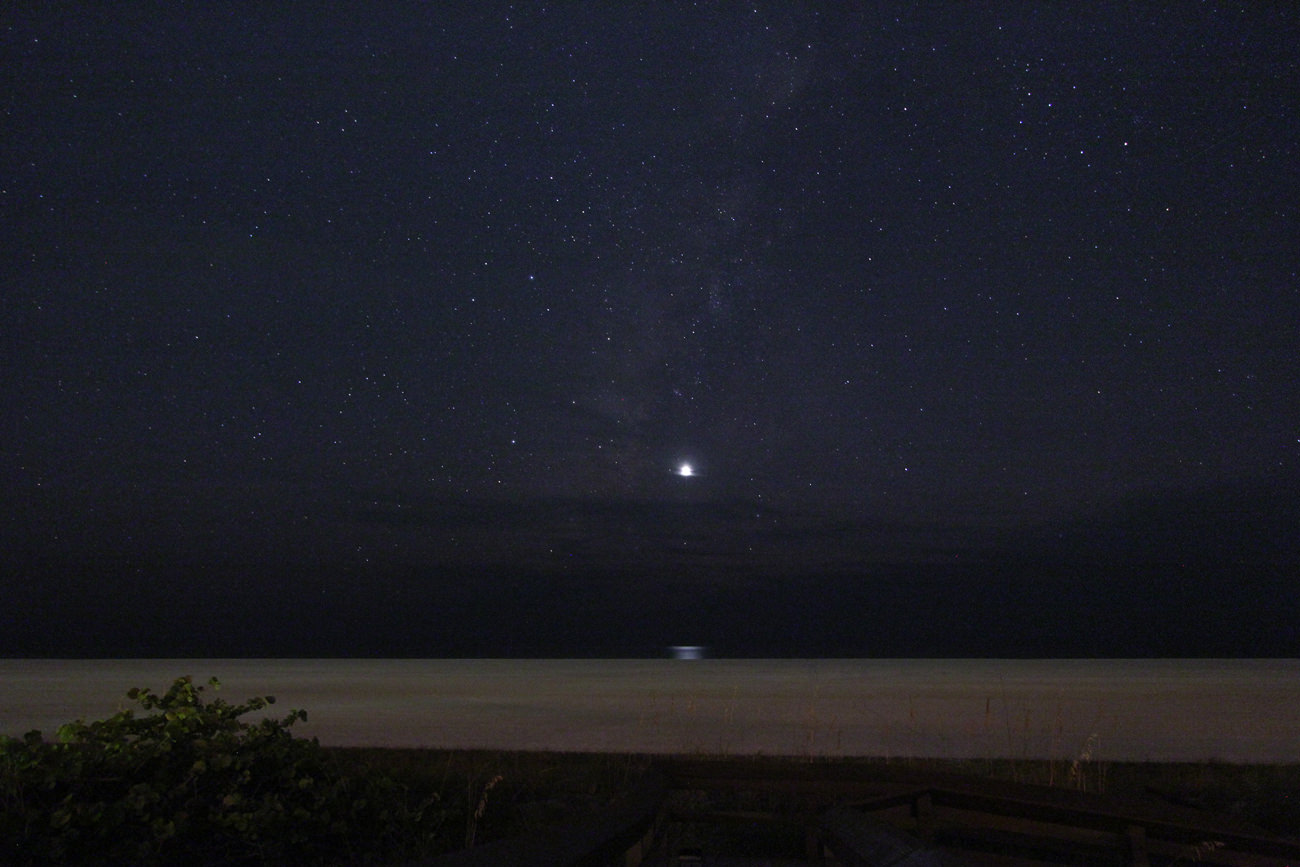Where have all the planets gone in early 2020? While most of the naked eye planets are hiding in the early dawn sky, one world dominates the evening: brilliant Venus.
Continue reading “Following the Inner Worlds: Mercury and Venus in 2020”Venus Rules the Dusk Skies at Greatest Elongation
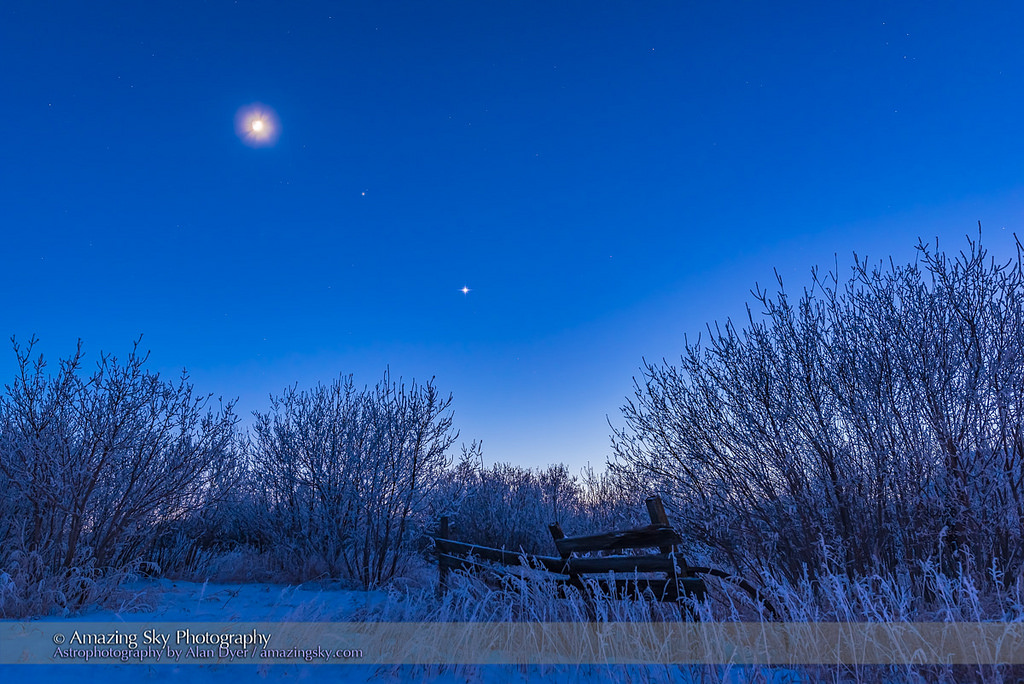
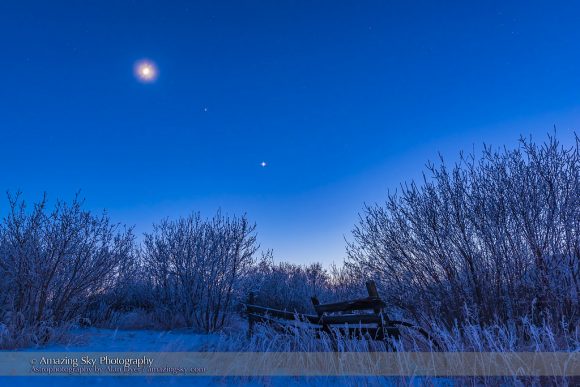
“What’s that bright light in the sky?” The planet Venus never fails to impress, and indeed makes even seasoned observers look twice at its unexpected brilliance. The third brightest natural object in the sky, Venus now rules the dusk, a fine sight for wintertime evening commuters. Venus reaches greatest elongation tomorrow, a excellent time to admire this dazzling but shrouded world of mystery.
Venus at greatest elongation
Only the two planets interior to Earth’s orbit – Mercury and Venus – can reach a point known as greatest elongation from the Sun. As the name suggests, this is simply the point at which either planet appears to be at its maximum angular distance from the Sun. Think of a big right triangle in space, with Venus or Mercury at the right angle vertex, and the Sun and Earth at the other two corners. High school geometry can come in handy!
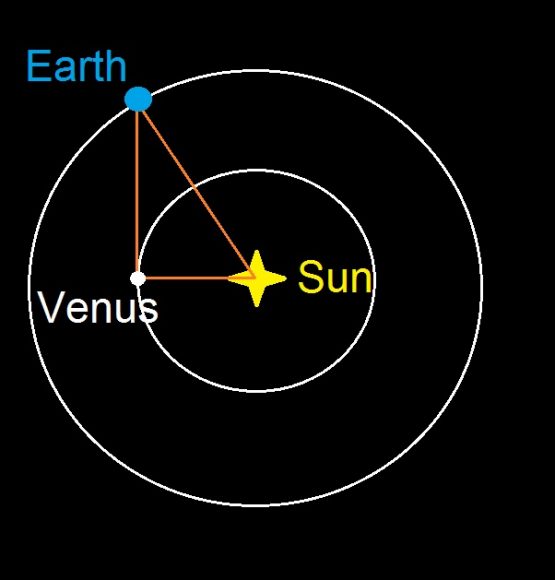
This Thursday on January 12th Venus reaches a maximum of 47 degrees elongation from the Sun at 11:00 Universal Time (UT) / 6:00 AM Eastern Standard Time, shining at magnitude -4.4. The maximum/minimum elongation for Venus that can occur is 47.3 to 45.4 degrees respectively, and this week’s is the widest until 2025.
Here’s some key dates to watch out for:
Jan 12th: Venus passes less than a degree from Neptune.
Jan 14th: Venus reaches theoretical dichotomy?
Jan 14th: Venus passes 3′ from +3.7 the magnitude star Lambda Aquarii.
Jan 17th: Venus crosses the ecliptic plane northward.
Venus and Mars reach ‘quasi-conjunction’ in late January.
January 30th: Venus crosses the celestial equator northward.
January 31st: The Moon passes 4 degrees south of Venus, and the two also form a nice equilateral triangle with Mars on the same date.
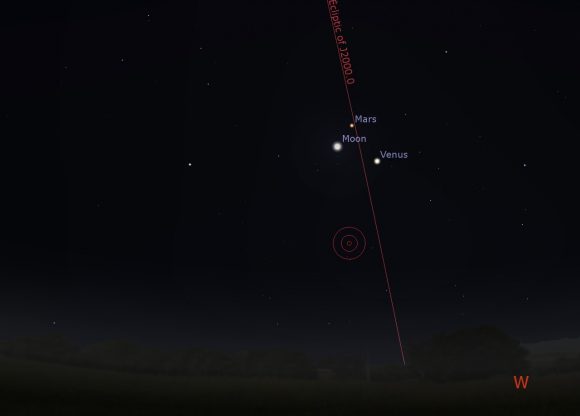
February 17th: Venus reaches a maximum brilliancy of magnitude -4.6.
March 26th: Solar conjunction for Venus occurs eight degrees north of the Sun … it is possible to spy Venus at solar conjunction from high northern latitudes, just be sure to block out the Sun.
Through the telescope, Venus displays a tiny 24.4” size half phase right around greatest elongation. You could stack 74 Venuses across the diameter of tomorrow’s Full Moon. When does Venus look to reach an exact half phase to you? This point, known as theoretical dichotomy, is often off by just a few days. This is a curious observed phenomenon, first noted by German amateur astronomer Johann Schröter in 1793. The effect now bears his name. A result of atmospheric refraction along the day/terminator on Venus, or an optical illusion?
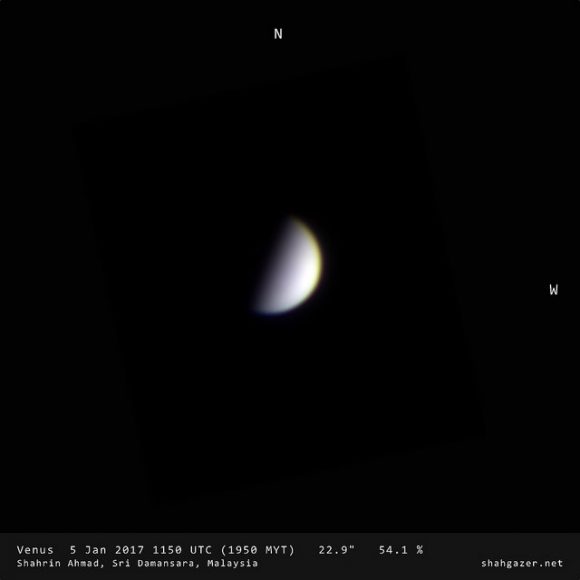
And hey, amateurs are now using ultraviolet filters to get actual detail on the cloud-tops of Venus… we like to use a variable polarizing filter to cut down the dazzling glare of Venus a bit at the eyepiece.
Also, keep an eye out for another strange phenomenon, known as the Ashen Light of Venus. Now,ashen light or Earthshine is readily apparent on dark side of the Moon, owing to the presence of a large sunlight reflector nearby, namely the Earth. Venus has no such large partner, though astronomers in the early age of telescopic astronomy claimed to have spied a moon of Venus, and even went as far as naming it Neith. An optical illusion? Or real evidence of Venusian sky glow on its nighttime side? After tomorrow, Venus will begin heading between the Earth and the Sun, becoming a slender crescent in the process. Solar conjunction occurs on March 25th, 2017. Venus sits just eight degrees north of the Sun on this date, and viewers in high Arctic latitudes might just be able to spy Venus above the horizon before sunrise on the day of solar conjunction. We performed a similar feat of visual athletics on the morning of January 16th, 1998 observing from North Pole, Alaska.
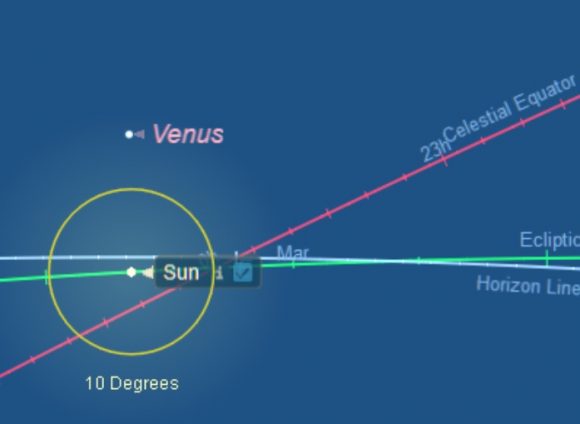
From there, Venus heads towards a fine dawn elongation on June 3rd, 2017. All of these events and more are detailed in our free e-book: 101 Astronomical Events for 2017.
Spying Venus in the Daytime
Did you know: you can actually see Venus in the daytime, if you know exactly where to look for it? A deep blue, high contrast sky is the key, and a nearby crescent Moon is handy in your daytime quest. Strange but true fact: Venus is actually brighter than the Moon per square arc second, with a shiny albedo of 70% versus the Moon’s paltry 12%. But Venus is tiny, and hard to spot against the blue daytime sky… until you catch sight of it.
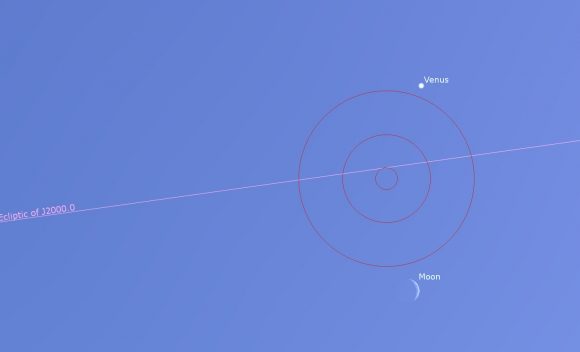
There’s another reason to brave the January cold for northern hemisphere residents: Venus can indeed cast a shadow if you look carefully for it. You’ll need to be away from any other light sources (including the Moon, which passes Full tomorrow as well with the first Full Moon of 2017, known as a Full Wolf Moon). And a high contrast surface such as freshly fallen snow can help… a short time exposure shot can even bring the shadow cast by Venus into focus.
If you follow Venus long enough, you’ll notice a pattern, as it visits very nearly the the same sky environs every eight years and traces out approximately the same path in the dawn and dusk sky. There’s a reason for this: 8 Earth years (8x 365.25 = 2922 days) very nearly equals 5 the synodic periods for Venus (2922/5=584 days, the number of days it takes Venus to return to roughly the same point with respect to the starry background, separate from its true orbit around the Sun of 225 days). For example, Venus last crossed the Pleiades star cluster in 2012, and will do so again in – you guessed it — in 2020. Unfortunately, this pattern isn’t precise, and Venus won’t also transit the Sun again in 2020 like it did in 2012. You’ll have to wait until one century from this year on December 10-11th, 2117 to see that celestial spectacle again….
Hopefully, we’ll have perfected that whole Futurama head-in-a-jar thing by then.
Watch Venus as it Wanders Through the Dawn in 2014
Are you a chronic early riser? Observational astronomy often means late nights and early mornings as daylight lengths get longer for northern hemisphere residents in February through March. But this year offers another delight for the early morning crowd, as the Venus is hanging out in the dawn skies for most of 2014.
You may have already caught sight of the brilliant world: it’s hard to miss, currently shinning at a dazzling -4.5 magnitude in the dawn. Venus is the brightest planet as seen from Earth and the third brightest natural object in the night sky after the Sun and the Moon.
Venus just passed between the Earth and the Sun last month on January 11th at inferior conjunction. Passing over five degrees north of the Sun, this was a far cry from the historic 2012 transit of the solar disk, a feat that won’t be replicated again until 2117 AD.
But February and March offer some notable events worth watching out for as Venus wanders in the dawn.
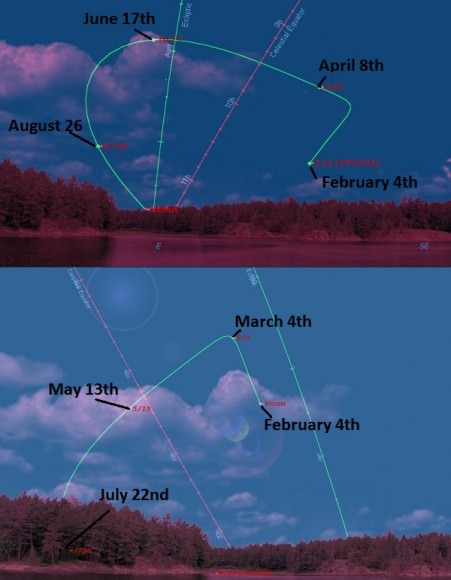
This week sees Venus thicken as a 48” 16% illuminated waxing crescent as it continues to present more of its daytime side to the Earth. We’ve always thought that it was a bit of cosmic irony that the closest planet too us presents no surface detail to observers: Venus is a cosmic tease. This assured that astronomers knew almost nothing about Venus until the dawn of the Space Age — guesses at its rotational speed and surface conditions were all widely speculative. Ideas of a vast extraterrestrial jungle or surface-spanning seas of seltzer water oceans gave way to the reality of a shrouded hellish inferno with noontime temps approaching 460 degrees Celsius. Venus is also bizarre in the fact that it rotates once every 243 Earth days, which is longer than its 224.7 day year — you could easily out walk a Venusian sunrise, that is if you could somehow survive to see it from its perpetually clouded surface!
Venus also passes 4.3 degrees from faint Pluto this week on February 5th. And while Pluto is a tough catch at over a million times fainter than Venus, it’s interesting to consider that NASA’s New Horizons and ESA’s Rosetta spacecraft are also currently off in the same general direction:
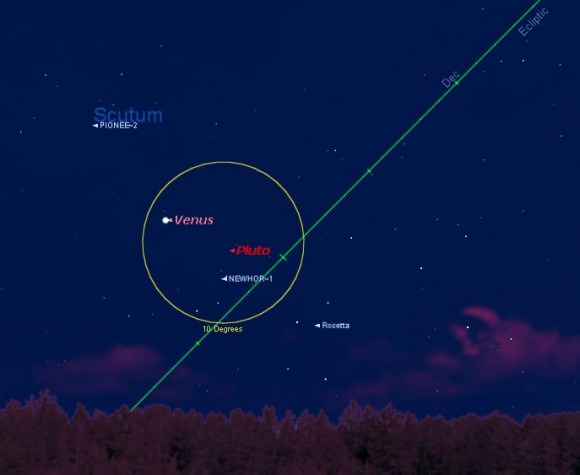
Venus also reaches greatest brilliancy at magnitude -4.6 next week on February 11th. Venus is bright enough to cast a shadow onto a high contrast background, such as freshly fallen snow. Can you see your “Venusian shadow” with the naked eye? How about photographically?
Venus then goes on to show its greatest illuminated extent to us on February 15th. This combination occurs because although the crescent of Venus is fattening, the apparent size of the disk is shrinking as the planet pulls away from us in its speedy interior orbit. Can you spy the elusive “ashen light of Venus” through a telescope? Long a controversy, this has been reported by observers as a dim “glow” on the nighttime hemisphere of Venus. Proposed explanations for the ashen light of Venus over the years have been airglow, aurorae, lightning, Venusian land clearing activity (!) or, more likely, an optical illusion.
And speaking of which, the crescent Venus gets occulted by the waning crescent Moon on February 26th. Observers in western Africa will see this occur in the predawn skies, and the rest of us will see a close pass of the pair worldwide. Can you spot Venus near the crescent Moon in the daytime sky on the 26th?
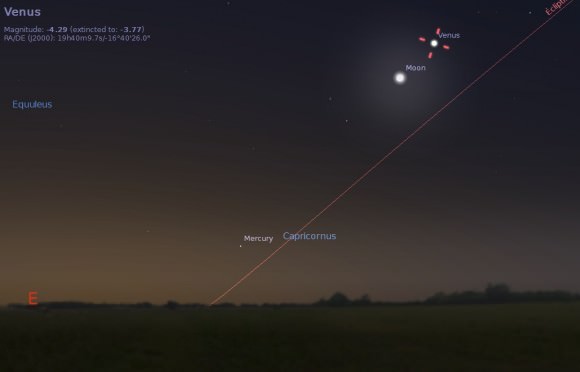
In March, Venus begins the slide southward towards the point occupied by the Sun months earlier and heads towards its greatest westward elongation for 2014 on March 22nd at 46.6 degrees west of the Sun. Interestingly, Venus is tracing out roughly the same track it took 8 years ago in 2006 and will trace again in 2022, when it will also spend a majority of the year in the dawn once again. The 8-year repeating cycle of Venus is a result of the planet completing very nearly 13 orbits of the Sun to our 8. Ancient cultures, including the Maya, Egyptians, and Babylonian astronomers all knew of this period.
Through the telescope, Venus appears at a tiny “half-moon” phase 50% illuminated at greatest elongation, a point known as dichotomy. It’s interesting to note that theoretical and observed dichotomy can actually vary by several days surrounding greatest elongation. An optical phenomenon, or a true observational occurrence? When do you judge that dichotomy occurs in 2014?
In April, one of the closest planetary conjunctions occurs of 2014 on the 12th involving Neptune and Venus at just 40’ apart, a little over the span of a Full Moon. Can you squeeze both into an eyepiece field of view? At +7.7th magnitude, Neptune shines at over 25,000 times fainter than Venus. Neith, the spurious “moon” of Venus described by 18th century astronomers lives!
But two even more dramatic conjunctions occur late in the summer, when Jupiter passes just 15’ from Venus on August 18th and Regulus stands just 42’ from Venus on September 5th. Fun fact: Venus actually occulted Regulus last century on July 7th, 1959!
From there on out, Venus heads toward superior conjunction on the far side of the Sun on October 25th, to once again emerge into the dusk sky through late 2014 and 2015.
Be sure to check out these dawn exploits of Venus through this Spring season and beyond!
Bright Venus Takes Center Stage in November
“What’s that bright object to the southwest at dusk?” We’ve already fielded more than a few such questions as Earth’s sister world shines in the dusk sky. Venus just passed its maximum elongation 47 degrees east of the Sun on November 1st, and currently shines at a brilliant magnitude -4.46. This is almost 16 times brighter than the brightest star in the sky, -1.46th magnitude Sirius.
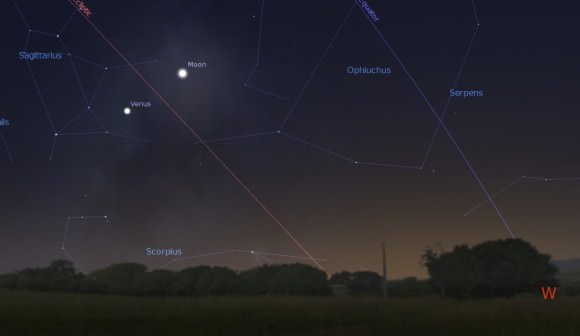
Just like the Moon, Venus goes through a full range of phases. Through the telescope, Venus currently presents a 26.7” diameter disk. That size will swell to almost 40” by month’s end, as Venus begins to approach the Earth and presents a noticeable crescent phase. We just passed dichotomy — the theoretical point where Venus presents a half-illuminated phase as seen from Earth — on October 31st, and Venus already shows a noticeable crescent:
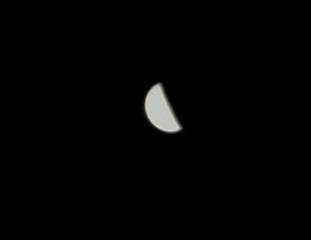
Note that we say “theoretical” because there’s typically a discrepancy of a day or two between predicted and observed dichotomy. This is also known as Schröter’s Effect. One probable cause for this is the dazzling appearance of the disk of Venus. We typically use a variable polarizing filter to cut the glare of Venus down at the eyepiece.
You might also note that Venus currently occupies the “basement” of the zodiac in the constellation Sagittarius. In fact, the planet is currently as far south as it can go, sitting at a declination of -27° 14’ on this very evening. You have to go all the way back to 1930 to find a more southerly declination of Venus, just 12’ lower!
But you won’t have to wait much longer to break that record, as the chart below shows for the most southerly declinations of Venus for the next half century:
| Year | Date | Declination |
| 2013 | November 6th | -27° 09’ |
| 2021 | “ “ | -27° 14’ |
| 2029 | “ “ | -27° 18’ |
| 2037 | “ “ | -27° 23’ |
| 2045 | “ “ | -27° 29’ |
| 2053 | “ “ | -27° 34’ |
| 2061 | “ “ | -27° 39’ |
Note that each event occurs on November 6th, and they’re spaced 8 years apart. Apparitions of Venus closely duplicate their paths in the sky over an 8 year cycle. This is because the planet nearly completes 13 orbits of the Sun for our 8. Venus “catches up” to the Earth on its interior orbit once every 584 days to reach inferior conjunction. It usually passes above or below the Sun from our vantage point, though last year it transited, a feat that won’t be witnessed again until 2117 AD.
How far south can Venus go? Well, its orbit is tilted 3.4 degrees relative to the ecliptic. It can reach a southern declination of -28 05’, though you have to go way back to 1874 for its last occurrence!
Today is also a great time to try your hand at spotting Venus in the daytime, as a 3-day old waxing crescent Moon lies about eight degrees to its upper right:
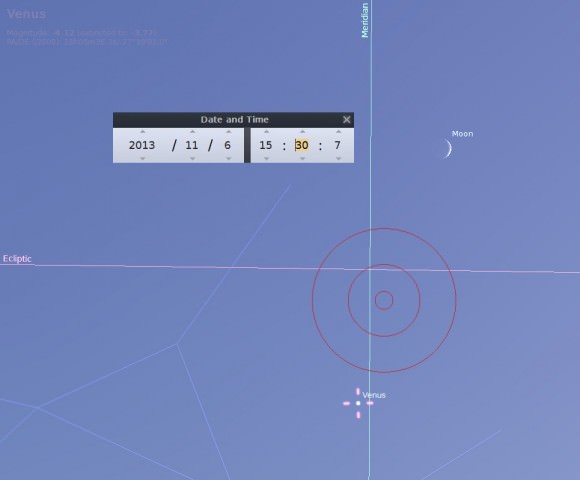
Note that seeing Venus in the daytime is surprisingly easy, once you known exactly where to look for it. Your best chances are around mid-afternoon at about 3PM local, when the daytime Moon and Venus lie highest in the southern sky. Did you know that Venus is actually intrinsically brighter per square arc second than the Moon? It’s true! The Moon actually has a very low reflective albedo of 12% — about the equivalent of fresh asphalt — while the cloud tops of Venus are more akin the fresh snow with an albedo of about 80%.
Its also worth checking out Venus and its local environs after nightfall as it passes near the Lagoon (M8) and the Trifid nebula (M8) on the night of November 6th. Continuing with its trek across the star rich plane of the heart of the Milky Way galaxy, Venus also passes near the globular cluster M22 on November 13th.
Venus also sits in the general of Pluto on November 15th, lying just 6.6 degrees south of it. Be sure to wave in the general direction of NASA’s New Horizons spacecraft bound for Pluto in July 2015 tonight as well, using the Moon and Venus for a guide:
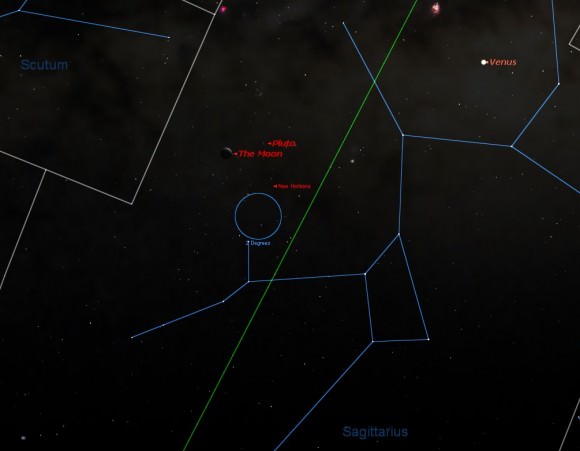
Another shot at seeing Venus paired with the Moon occurs on December 5th.
Venus also presents a maximum area of illumination on December 6th, and will shine at its brightest on December 10th at magnitude -4.7. Can you catch it casting a shadow? The best time to search for this illusive phenomenon would be just before New Moon on December 2nd. A dark sky site away from any other sources of illumination, and a snow covered ground providing high contrast also helps. Fortunately, snow isn’t in short supply in the northern hemisphere in December!
Venus is currently the only naked eye planet in the November early evening sky. We always thought that it’s a bit of a cosmic irony that the nearest planet presents a dazzling, but featureless white disk as seen from Earth. Diligent amateurs have, however, been able to tease out cloud patterns on Venus using UV filters.
Another elusive phenomenon to watch for as Venus reaches a crescent phase is ashen light. Long reported by observers, a faint glow on the night side of Venus is something that persists, but shouldn’t be. A similar effect seen on the night side of the Moon known as Earthshine is easily explained by sunlight being reflected off of the Earth… but Venus has no moon. What gives? Frequent explanations over the years have been aurorae, electrical activity, airglow, or, more frequently cited, observer bias. The brain wants to see a filled in space, and promptly inserts it betwixt the dazzling horns of the planet.
Keep an eye on Venus as it reaches maximum brilliancy and heads towards inferior conjunction on January 11th, 2014, and a rare chance to see it on said date… more to come!

